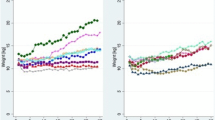Abstract
The aim of this study was to determine the effect of splenectomy in the short bowel syndrome. Twenty-four Wistar-albino rats weighing between 210 and 375 g were used. They were divided into three groups. In group A, short bowel syndrome (SBS) was created by 75 % bowel resection. In group B, SBS and splenectomy was performed. In group C, after transecting the bowel, it was anastomosed. Before and 45 days after the procedures, all rats were weighed. In all three groups, the first and final weight of the rats, the final bowel weight and length, the ileal and jejunal crypt depths, the villus height, the luminal diameter, the bowel wall thickness, and the number of apoptotic cells and mitosis per 100 crypt cell were compared. Periportal fibrosis, infiltration, bile stasis, and bile duct proliferation were detected in liver samples. The rat intestinal length and weight was the least in group B while the jejunal crypt depth was higher in group B than in group A and it was exactly the opposite for the jejunal and ileal villus heights. The ileal and jejunal luminal diameter, the ileal bowel wall thickness, the jejunal and ileal apoptotic cell number, the jejunal mitosis, and the periportal fibrosis were highest in group B. Adding splenectomy to an SBS model has a negative impact on bowel adaptation.



Similar content being viewed by others
References
Batra A, Beattie RM (2013) Management of short bowel syndrome in infancy. Early Hum Dev 89(11):899–904
Tappenden KA (2014) Intestinal adaptation following resection. JPEN J Parenter Enteral Nutr 38(1 Suppl):23S–31S
Uko V, Radhakrishnan K, Alkhouri N (2012) Short bowel syndrome in children: current and potential therapies. Paediatr Drugs 14(3):179–188
Jeppesen PB (2013) Teduglutide for the treatment of short bowel syndrome. Drugs Today (Barc) 49(10):599–614
Shaw D, Gohil K, Basson MD (2012) Intestinal mucosal atrophy and adaptation. World J Gastroenterol 18(44):6357–6375
Di Sabatino A, Carsetti R, Corazza GR (2011) Post-splenectomy and hyposplenic states. Lancet 378(9785):86–97
Tarantino G, Savastano S, Capone D, Colao A (2011) Spleen: a new role for an old player? World J Gastroenterol 17(33):3776–3784
Zoli G, Corazza GR, Wood S, Bartoli R, Gasbarrini G, Farthing MJ (1998) Impaired splenic function and tuftsin deficiency in patients with intestinal failure on long term intravenous nutrition. Gut 43(6):759–762
Sukhotnik I, Yakirevich E, Coran AG, Siplovich L, Krausz M, Hirsh M, Sabo E, Shiloni E (2002) Effect of transforming growth factor-alpha on intestinal adaptation in a rat model of short bowel syndrome. J Surg Res 108(2):235–242
Wang L, Tang Y, Rubin DC, Levin MS (2007) Chronically administered retinoic acid has trophic effects in the rat small intestine and promotes adaptation in a resection model of short bowel syndrome. Am J Physiol Gastrointest Liver Physiol 293(2):G517–G518
Warner BW (2006) Short bowel syndrome. In: Grosfel JL, O’Neill JA Jr, Fonkalsrud EW, Coran AG (eds) Pediatric Surgery. Mosby, Philadelphia, pp 1369–1382
Jaksic T, Gutierrez IM, Kang KH (2012) Short bowel syndrome. In: Coran AG, Adzick NS, Krummel TM, Laberge JM, Shamberger RC, Caldamone AA (eds) Pediatric Surgery. Elsevier-Saunders, Philadelphia, pp 1135–1145
Di Sabatino A, Rosado MM, Ciccocioppo R, Cazzola P, Morera R, Corazza GR, Carsetti R (2005) Depletion of immunoglobulin M memory B cells is associated with splenic hypofunction in inflammatory bowel disease. Am J Gastroenterol 100(8):1788–1795
Ryu S, Kodama S, Ryu K, Schoenfeld DA, Faustman DL (2001) Reversal of established autoimmune diabetes by restoration of endogenous beta cell function. J Clin Invest 108(1):63–72
Kodama S, Kühtreiber W, Fujimura S, Dale EA, Faustman DL (2003) Islet regeneration during the reversal of autoimmune diabetes in NOD mice. Science 302(5648):1223–1227
Chong AS, Shen J, Tao J, Yin D, Kuznetsov A, Hara M, Philipson LH (2006) Reversal of diabetes in non-obese diabetic mice without spleen cell-derived beta cell regeneration. Science 311(5768):1774–1775
Acknowledgments
Karabulut B planned and did the experiment and wrote the paper. Karaman NA contributed to this paper. Caydere M evaluated the pathology. Karabulut R is the guarantor and contributed to the experiment and wrote the paper.
Author information
Authors and Affiliations
Corresponding author
Ethics declarations
Conflict of Interest
The authors declare that they have no conflict of interest.
Rights and permissions
About this article
Cite this article
Karabulut, B., Karaman, N.A., Caydere, M. et al. Effect of Splenectomy to Short Bowel Syndrome in Rats. Indian J Surg 79, 201–205 (2017). https://doi.org/10.1007/s12262-016-1465-2
Received:
Accepted:
Published:
Issue Date:
DOI: https://doi.org/10.1007/s12262-016-1465-2




